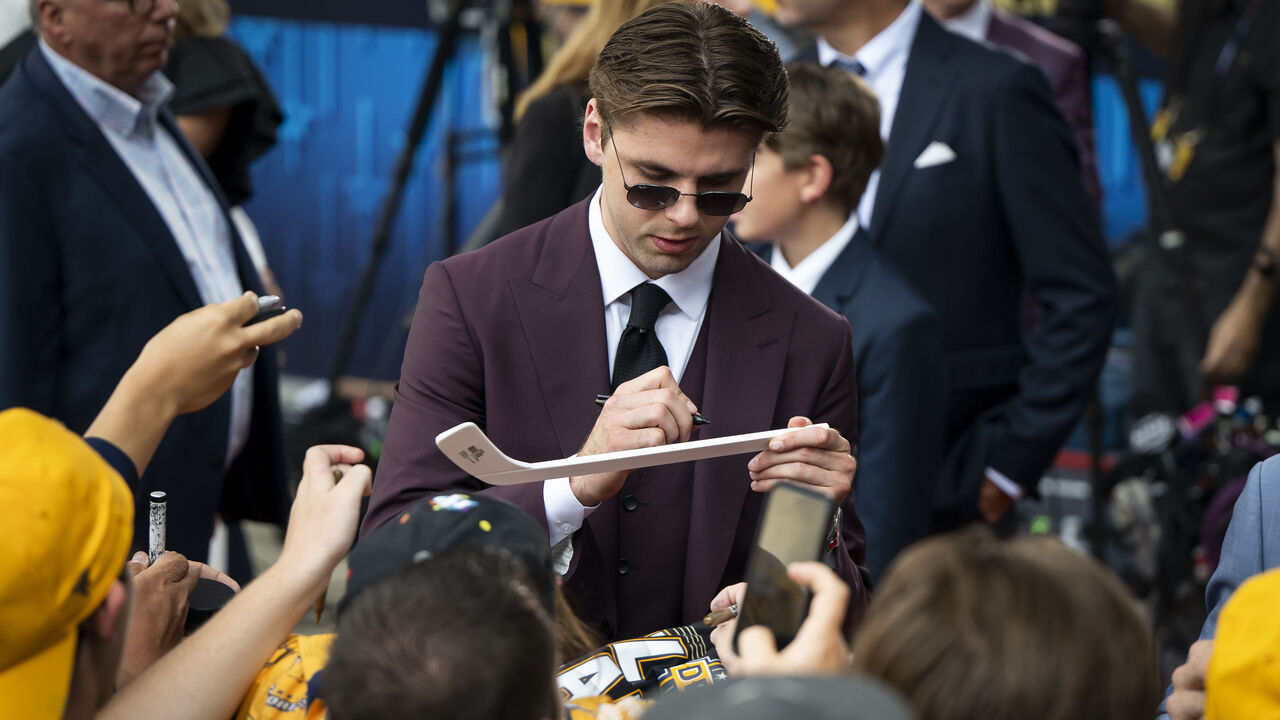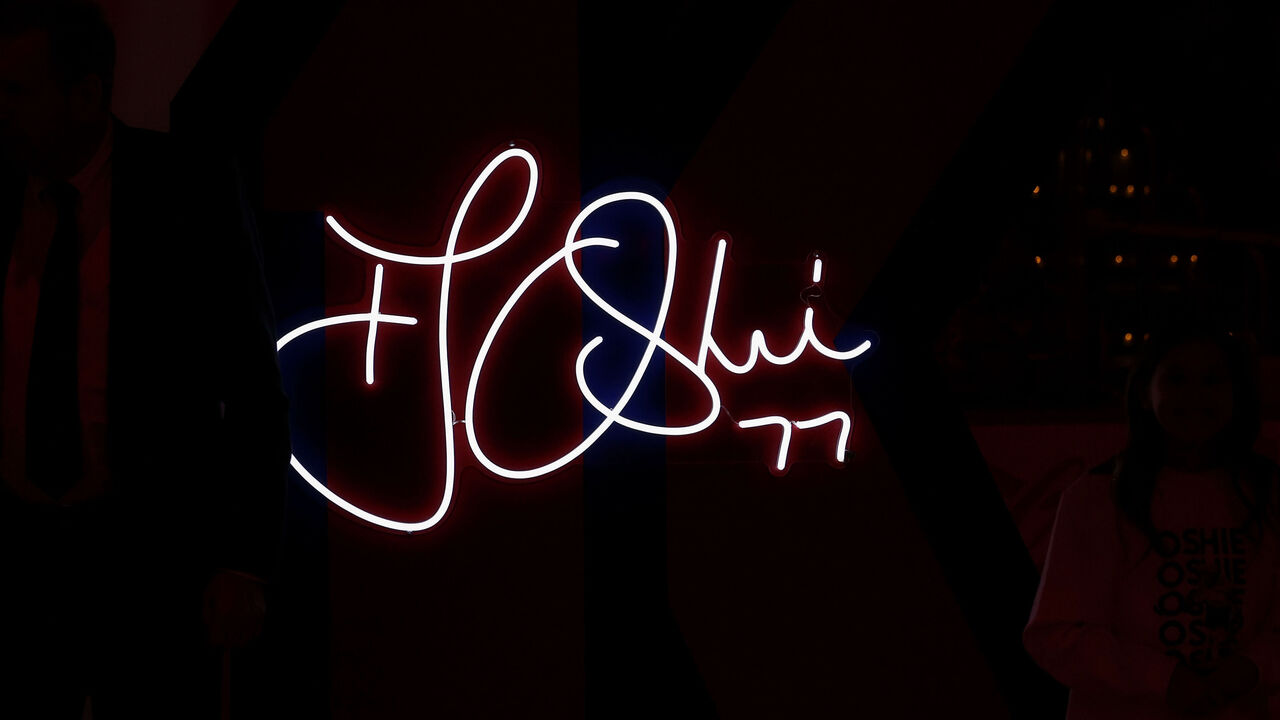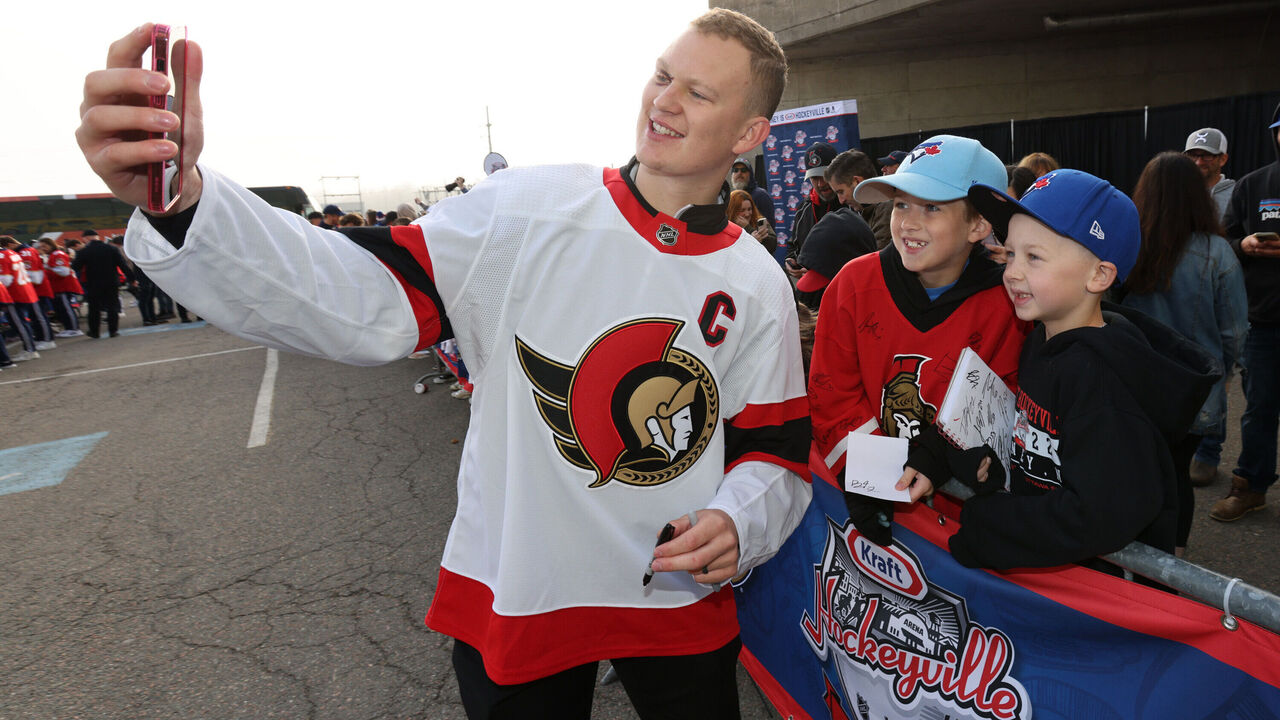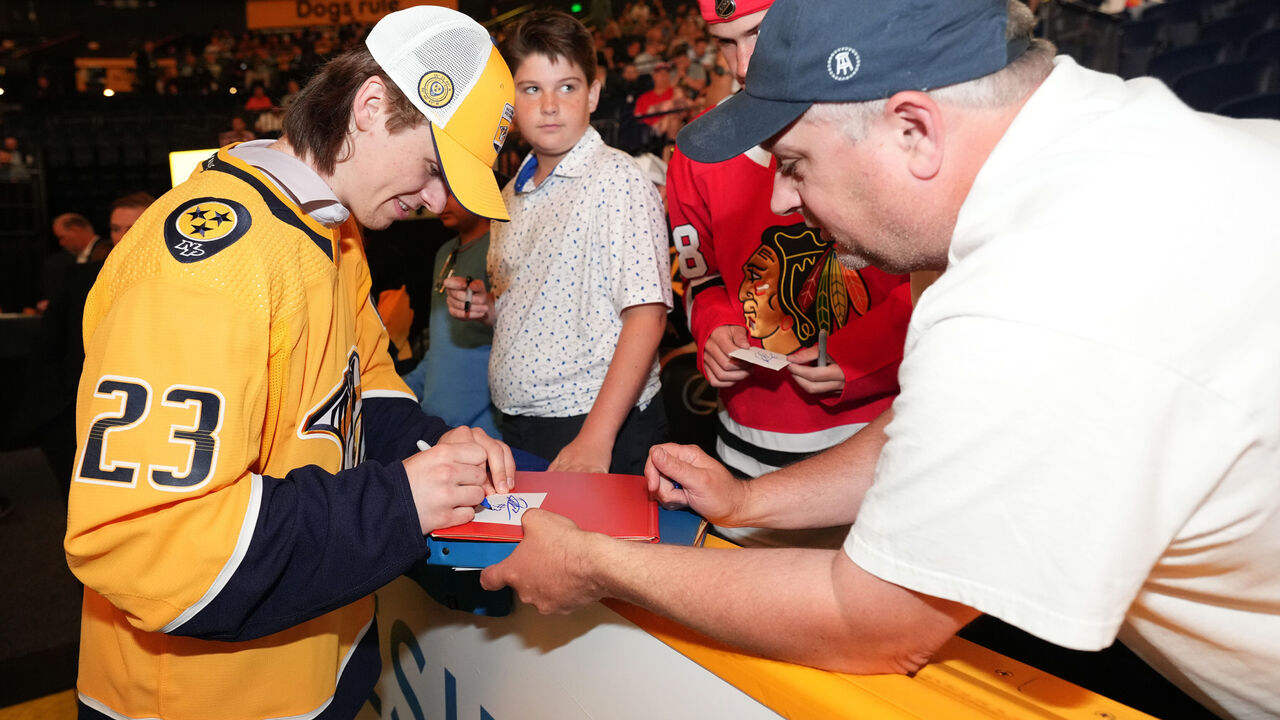How NHLers stickhandle through the world of autographs
David Pastrnak was sipping a beer last summer, minding his own business on a sunny patio in his native Czechia when another restaurant patron approached his table.
The man asked the Boston Bruins sniper to sign his forearm in black permanent marker. He claimed to have a friend nearby who could turn Pastrnak's scribbled name and jersey number into a tattoo within a couple of hours.
"His girlfriend came and gave me her chest, so I signed her chest," Pastrnak recalled during All-Star Weekend in Toronto this past February.

Pastrnak's arguably a top-10 player and top-10 personality in the NHL - someone who's both immensely talented and, by hockey's buttoned-up standards, extremely charismatic. An icon in a small, sports-loving Eastern European country, he's used to interacting with strangers in the offseason.
Still, Pastrnak couldn't believe it when the couple returned to his table 90 minutes later, freshly inked. "They did it, and I buy them a round of beers and shots. Because I thought that was kind of crazy," Pastrnak said with a broad smile. "It was wild. Before I signed it, I was like, 'Are you guys sure? I wouldn't do it ...'
"But they wanted it, so they got it."
Cursive writing is largely obsolete in our modern digital culture, yet an autograph from an actor, musician, politician, or athlete continues to hold sentimental (and sometimes financial) value. One stroke of a Sharpie can turn an ordinary item into a prized possession. Often the product of a face-to-face exchange between celebrity and paying customer, the autographed item can be proudly displayed, passed down the family tree, put up for auction, or, in the case of the Pastrnak superfans, recast as a template for body art.
"The appeal of the autograph is the personal touch," Joe Orlando, the executive vice president of sports for Heritage Auctions, said.
"No matter what the medium is - a hockey puck, a basketball, a photograph, a trading card - the fascination with autographs is that it gets you closer to the sports figure. The autograph changes what that item means to the recipient."

Pastrnak can't remember how he developed the look of his autograph, which is straight out of the pro athlete playbook: capital D, line, capital P, line, No. 88. ("I wish I came up with something better," he said.) Other NHLers interviewed for this story last season could pinpoint a specific time and place, though.
In the early 2010s, Bobby McMann routinely scribbled his name into a notebook hidden from his teacher's gaze at Wainwright High School in rural Alberta. Like countless teenagers across the world, he dreamed of one day being asked for an autograph and knew it wouldn't hurt to start practicing.
"I just started playing with it, killing time in class when I wasn't paying attention but probably should have been," McMann, the undrafted 28-year-old Maple Leafs forward, smiled. "I was ripping my signature over and over."
"You'd always doodle in school when you weren't paying attention," Frank Vatrano of the Ducks said.
"I would practice as if I were a pro," Blue Jackets forward Kent Johnson recalled. "I don't know why. I guess I was bored? Kind of like, well, hopefully I'll have to be good at this autograph thing someday."
Alex Tuch of the Sabres honed his during study hall alongside former U.S. National Team Development Program teammate Sonny Milano. "I did mine one day. Sonny checked it out and was like, 'No, no, what about if you did the 'A' like this?'" Tuch said as he signed the air by his stall at Buffalo's KeyBank Center. "I was like, 'Hmm, OK,' and I did the A that way, and he was like, 'Perfect!' Then I figured out where to put the number 89. It's above the 'uch.'"

Flames defenseman Jake Bean remembers being a rookie on the WHL's Calgary Hitmen and freezing when a fan handed him a jersey at a team event. He turned to a veteran sitting next to him at the signing table and said, "I don't know what to do."
"He leaned over and just did it for me that one time," Bean added. "My name's simple so I've stuck with the same signature since."
Fifteen-year-old Tom Wilson prepared himself for the junior hockey spotlight by workshopping various styles with his future sister-in-law at the family's kitchen table. "We were just trying a bunch of different stuff. It's evolved a lot over the years," said the Capitals forward, now 30. "If you go back to the first autograph I signed in the OHL, it was probably terrible."
Most active NHLers learned how to write in cursive in elementary school. "Third grade! Mrs. Campola!" Panthers defenseman Nate Schmidt said. "Third grade," the Kings' Alex Turcotte confirmed. However, since cursive is rarely used to communicate nowadays, the average autograph has become unimaginative. Some are laughably bad: illegible initials and nothing more.
"You'll see some sports figures and celebrities from past generations have such beautiful and legible and stylish autographs compared to current-day athletes," Orlando said of Gordie Howe, Maurice Richard, and their peers.
"Why? Society simply doesn't require athletes to have great penmanship. We don't write letters anymore. We don't use handwriting in daily life nearly as much. We're in the digital age in every way."
Time is a variable, too. The modern athlete is inundated with requests. If an NHLer is tasked with signing hundreds of trading cards as part of an Upper Deck endorsement deal, he's naturally not going to have a lot of time to spend on each one. If he's being swarmed on a red carpet or at a charity golf tournament, he's going to alternate between signing, making small talk, and smiling for selfies.
"The selfie has replaced the signature in some ways," former NHL goalie turned broadcaster Jamie McLennan said. "You can see your face with that person. Make it your profile picture on social media. What's cooler, the selfie or the autographed stick or jersey? There's honestly an argument for both."

There are three types of people who ask for autographs: the fan with a personal collection, the employee of a reputable corporation or charity, and the "seeker." That last type also goes by "hound" or "hunter" because they acquire autographs for the sole purpose of flipping them for profit, typically through online marketplaces like eBay and with the athlete not receiving a cut.
Seekers anxiously wait at elevator banks at host hotels for the NHL's annual draft and All-Star weekends, hoping to corner a player. They camp out at airport terminals at all hours. They lug around large plastic binders stuffed with trading cards, index finger jammed between two pages for quick access when a player of interest exits the arena following a morning skate.
For transcendent stars, it can feel a little like stalking.
"You throw them out the door, they come from the window," is how all-timer Jaromir Jagr once articulated his distaste for the hardcore, persistent seekers.
Asked for his thoughts, longtime NHLer Garnet Hathaway paused.
"There's a hustle to it," the Flyers forward said after a few beats. "If they're selling what we sign, they're working hard. Most players, I would assume, would rather the seekers be a little bit more forthright and say where these autographs are actually going. It's kind of unknown unless you ask, right?"
"Some cities are different from others," the nine-year veteran added. "Some guys follow you around a little farther than you feel comfortable with. It's unfortunate, with some people looking just to sell the autographs when you have kids waiting there too. The kids really just want it for their own personal collection. You can't differentiate between the two, really. It's tough."

Schmidt, another veteran of more than 500 games, knows his way around each NHL city and has a similar view. The whole seeker shtick gets old quickly, especially if the guy is ungrateful. "A lot of times, it is what it is," Schmidt said. "But when they get a little bit snippy ..."
Schmidt signs his full name for kids but downsizes it for seekers to make the autograph less appealing and original. Hathaway sometimes personalizes his - "To Jimmy," for instance - to make it more difficult for seekers to find a buyer. Other NHLers, multiple players told theScore, have clapped back in a less subtle way, telling seekers they need to cough up $20 per autograph.
"I'm going to start being like, 'Yeah, if you've got a toonie, I'll do it.' Who carries toonies around now? I'm going to see what they say," Schmidt joked.
McLennan, an NHL goalie from 1993-2007, remembers being stunned by ex-Flames captain Jarome Iginla's graciousness after arriving at a road hotel at 3 a.m.
"A lot of the people waiting were autograph seekers, and they'd want him to sign 8-by-10 photos so they could sell them," McLennan said. "I asked him, 'Why do you stop?' He said, 'Jamie, think about the time that they've put in to stand there and wait. For me to sign for them and for them to make a little bit of money, I have no problem with it.' It just gave me a different perspective."
In other words, every player has his own comfort zone - even with true fans.
For instance, Tuch has no issue signing his name on shoes or phones, but after watching a viral video of Devils star Jack Hughes autographing a woman's arm for a tattoo, he's out on that particular genre. "I saw that," Tuch said, "and I was like, 'I would never sign a person's body part. Never.'"
Vatrano, a self-described "big shoe guy," tends to deny two requests: body parts and sneakers. "I just never want to ruin shoes, you know?" he said.
Logan Thompson still doing autograph signing here minutes after being traded by Golden Knights to Capitals pic.twitter.com/V0ozGdv6pn
— Tom Gulitti (@TomGulittiNHL) June 29, 2024
Rangers goalie Jonathan Quick claims to have autographed a half-eaten grilled cheese sandwich. Maple Leafs goalie Joseph Woll has inked a brick ("Brick Woll"). Blackhawks forward Taylor Hall once put his name on a printout of insider Bob McKenzie's famous "the trade is one for one" tweet from 2016. Quinn Hughes of the Canucks recently forged his brother Jack's signature for a young kid, eliciting laughs from a crowd of Vancouver fans.
"Somebody wanted me to sign something a little inappropriate," Wilson said of a strange request on a red carpet. "I just said, 'No. Respectfully, no.' And then she said, 'OK, will you sign my water bottle?' and I said, 'Yeah, sure.'"
The vast majority of interactions between players and fans are pleasant and casual. Even the top players aren't overly famous. They don't require Taylor Swift-level security, if any. This access can lead to heartwarming moments, like a fan gifting a homemade bracelet, painted portrait, or handwritten note.
Players were wide-eyed, impressionable hockey fans themselves once upon a time. Utah's Clayton Keller, a St. Louis native, wore the No. 5 growing up after Blues defenseman Barret Jackman tossed him a puck. Hathaway, 32, still has a late-1990s hockey stick used by the Capitals' Calle Johansson. It's decorated with autographs from Caps players, including stars Peter Bondra and Olaf Kolzig.
"You see a lot of yourself in the kids we interact with," Hathaway said.
Avalanche forward Miles Wood mailed Alex Ovechkin a trading card when he was around 8 years old. He included a note that said he'd one day lay a "big body check" on Ovechkin if the superstar didn't send him an autograph.
Ovechkin didn't respond but caught wind of the threat ahead of Wood's first NHL game against the Caps. He made sure Wood, then a Devils player, got his wish.
"To Miles, Take it easy tonight!!!" Ovechkin wrote in permanent black marker on a glossy photograph. He added a smiley face and his autograph.
John Matisz is theScore's senior NHL writer. Follow John on Twitter (@MatiszJohn) or contact him via email ([email protected]).